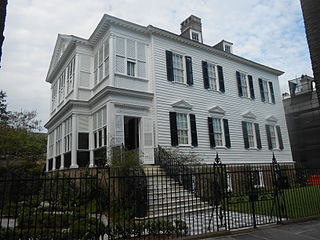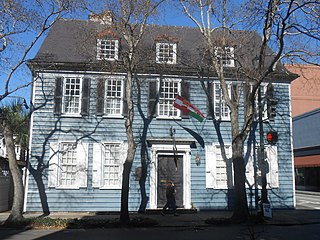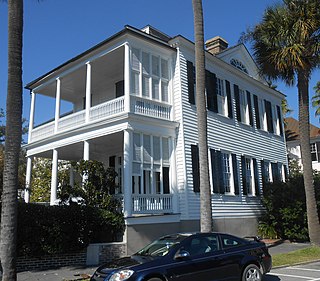
Fort Wagner or Battery Wagner was a beachhead fortification on Morris Island, South Carolina, that covered the southern approach to Charleston Harbor. It was the site of two American Civil War battles in the campaign known as Operations Against the Defenses of Charleston in 1863, and it is considered one of the toughest beachhead defenses constructed by the Confederate Army.
The First Battle of Fort Wagner was fought on July 10 and 11, 1863, on Morris Island in Charleston harbor during the American Civil War. An attempt by the Union Army to capture Fort Wagner was repulsed. The more famous Second Battle of Fort Wagner, which involved an assault by the 54th Massachusetts, would be fought on July 18.

The Battle of Secessionville was fought on June 16, 1862, during the American Civil War. Confederate forces defeated the Union's only attempt to capture Charleston, South Carolina, by land.

St. Mary of the Annunciation Roman Catholic Church is the first Roman Catholic parish in the Carolinas and Georgia. The current building at 93 Hasell St. in Charleston, South Carolina, is the third structure to house the congregation on this site.
Melton Peter Demetre Park is a municipal park in Charleston, South Carolina. Some locals still refer to it by the nickname "Sunrise Park", the park was officially dedicated and named Melton Peter Demetre Park around 2007 after its owner, who deeded the land to the City Of Charleston for use as a park.

The Col. William Rhett House is a historic, stuccoed brick two-story home at 54 Hasell St., Charleston, South Carolina. It was built in 1712 as the main house for Point Plantation later known as Rhettsbury, lying outside the walled city's limits by Col. William Rhett. The plantation was later folded into the historic Ansonborough neighborhood.

The William Washington House is a pre-Revolutionary house at 8 South Battery, Charleston, South Carolina. It is the only pre-Revolutionary house on Charleston's Battery. Thomas Savage bought the lot at the southwest corner of Church St. and South Battery in 1768 and soon built his house there. The resulting structure is a nationally important, Georgian style, square, wooden, two-story house on a high foundation.

The James Simmons House is a late 18th-century house at 37 Meeting Street, Charleston, South Carolina which was, at one time, the most expensive house sold in Charleston. It was likely built for James Simmons, a lawyer. By 1782, it was home to Robert Gibbes, a planter. Louisa Cheves, a prominent antebellum writer, was born at the house on December 3, 1810. In 1840, Otis Mills, the owner of the Mills House Hotel, bought the house for $9,000. In October 1862, during the Civil War, the house was loaned to Gen. Pierre Beauregard, who used the house as his headquarters until August 1863. In 1876, Michael P. O'Connor, later a member of Congress, bought the house.

The Louis DeSaussure House is an antebellum house at 1 East Battery, Charleston, South Carolina. The house was designed and built for Louis DeSaussure by William Jones and completed in late 1859. The three-story, masonry house follows a traditional side hall plan; two adjacent parlors are fronted with piazzas along the south side while a stair hall runs along the north side with a front door facing east onto East Battery. In 1865 during the Civil War, the house was damaged when evacuating Confederate forces blew up a large cannon at the corner of East Battery and South Battery; a piece of the cannon was lodged in the attic of the house. The balconies on the East Battery façade and window ornaments were installed when the house was restored after the earthquake of 1886 by Bernard O'Neill, who bought it in 1888. The house was used by the military to house Navy officers during World War II and was later converted into apartments. The carriage house for 1 East Battery was later subdivided into a separate house known as 2 South Battery.

The Robert Gibbes House in Charleston, South Carolina, was built in the Adamesque style at least by the time Robert Gibbes, Jr. was occupying it in 1819, perhaps earlier.

The Elias Vanderhorst House at 28 Chapel Street, Charleston, South Carolina, is a four-story mansion house which was built around 1835 as a home for members of the prominent Vanderhorst family of plantation owners.

The John Bickley House is an early 19th-century house at 64 Vanderhorst St., Charleston, South Carolina. The construction date for the house has been the subject of debate for many years, but the current consensus places the date as after 1824. John Bickley bought the property upon which the house stands in 1824 for $707.94, and in 1826, the house was placed in a trust for his wife, Mary Desel. The low price for the large lot and the transfer to the trust suggest that the house was built for Bickley. Bickley was a lumber factor who also planted rice at Woodstock Plantation in Goose Creek, South Carolina. The two-and-a-half-story Flemish bond, brick house sits on a high basement with a two-story piazza along the south facade that wraps to each side. In both interior and exterior details, the house reflects the Regency style.

The John Drayton House is a two-story wooden residence constructed on property that had been given by the state's first lieutenant governor, William Bull, to his son-in-law, John Drayton. The house was built, probably by John Drayton, some time after 1746 with alterations made in about 1813 and again in about 1900. Over time, the house has been attributed to different owners; during most of the 20th century, the house was credited to James Shoolbred, the first British consul in Charleston, with a construction date of about 1793.

The John Lining House is one of the oldest houses in Charleston. Although the lot upon which the house stands was first conveyed to French Huguenot immigrant Jaques DeBordeaux in 1694, it is uncertain when the house was built; the first mention of a house appears in a 1715 deed by which the property, including a dwelling, was conveyed to William Harvey, Jr. In 1757, the house was received by Mrs. Sarah Lining, the wife of Dr. John Lining. Although the couple owned the house for less than one year before transferring it to John Rattray, Dr. Lining's name stuck as the name of the dwelling. In 1780, the building was acquired by Dr. Andrew Turnbull, the founder of New Smyrna, Florida, who opened in the house the first of a long series of apothecary shops which remained until 1960.

The Isaac Holmes Tenement is a pre-Revolutionary house in Charleston, South Carolina. In 1721, Isaac Holmes acquired the parcel upon which 107 Church Street was built. It appears that he built a house on the land, but whatever structure he had built was lost in a fire in 1740 that wiped out many buildings in the area.

The Daniel Elliott Huger House was the last home of a Royal governor in South Carolina.

Constructed about 1810, the two-and-one-half story George Chisolm House is the first house to have been built upon the landfill project that formed Charleston, South Carolina's famous Battery.
The John Schnierle House is an antebellum house in Charleston, South Carolina that was the home of Mayor John Schnierle.




















